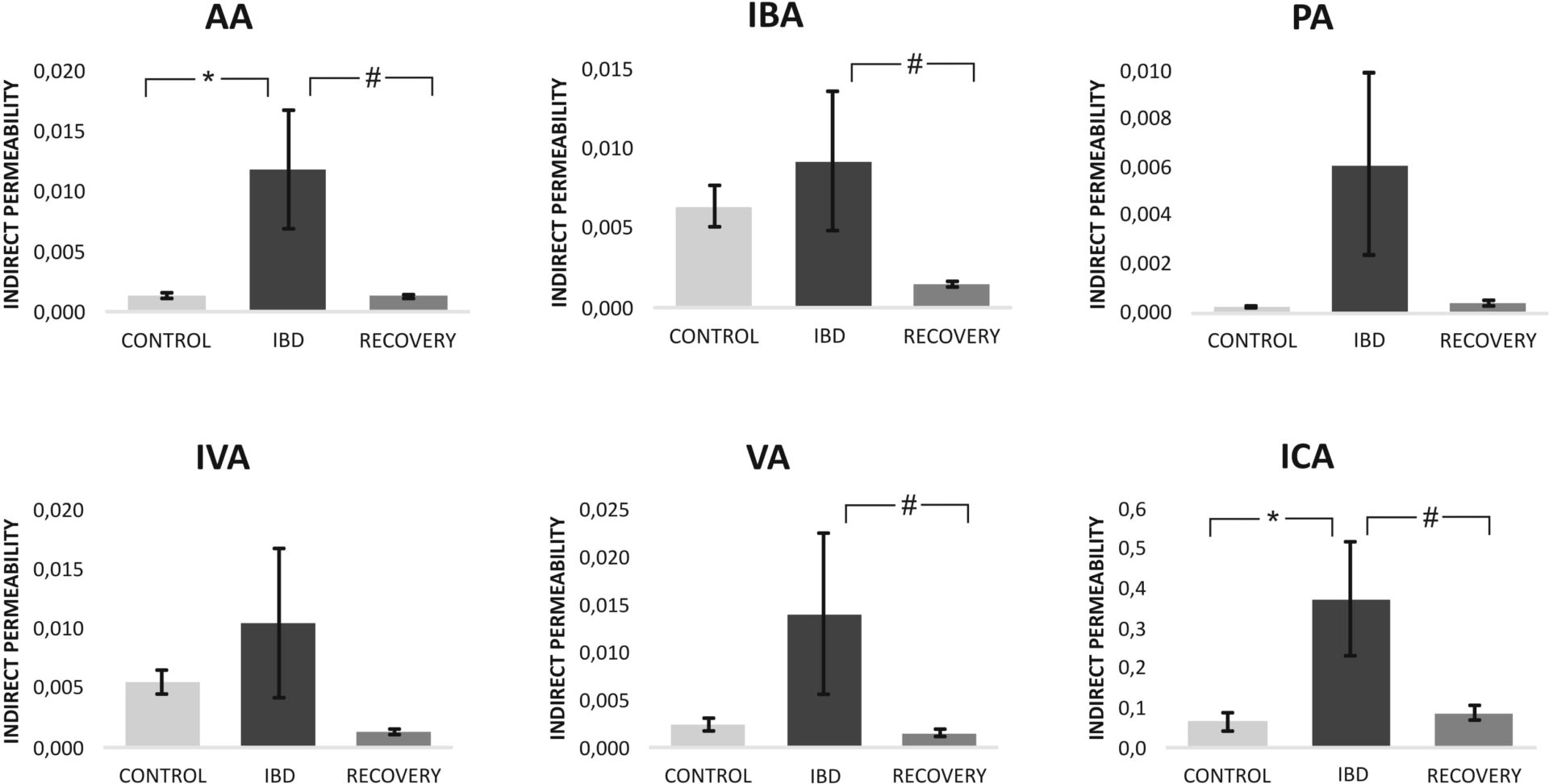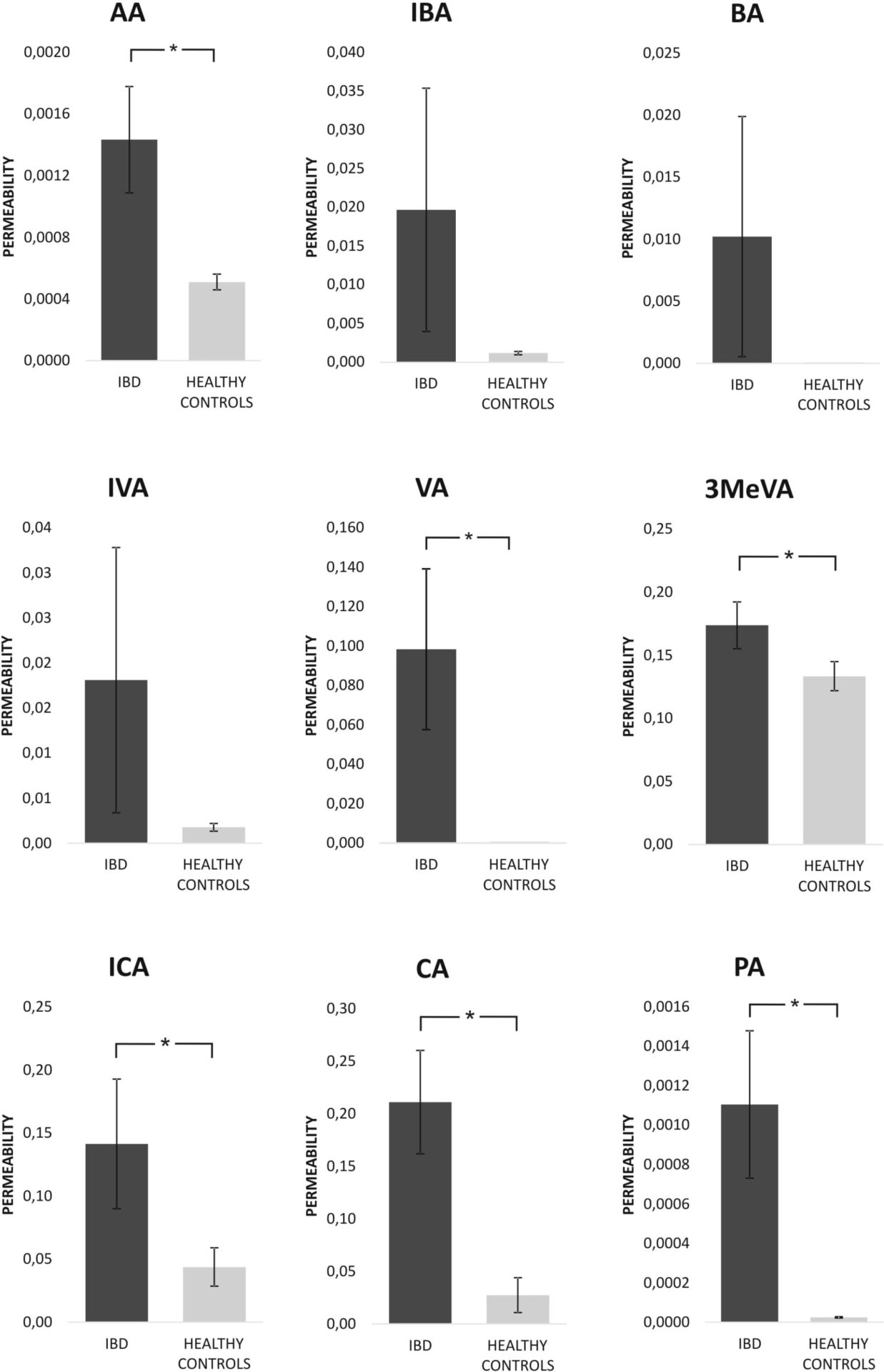Background. Impaired gut-blood barrier has been noticed in a variety of diseases, including cardiovascular and metabolic diseases (1, 2). Especially intestinal diseases such as inflammatory bowel disease (IBD) are characterized by “leaky gut” (3, 4). Therefore, functional evaluation of the gut-blood barrier is a promising diagnostic marker. We hypothesized that gut bacteria-produced short-chain fatty acids (SCFA) may serve as a marker in IBD. Methods. Animal study. Male, Sprague Dawley rats were anaesthetized i.p. with a mixture of ketamine (90 mg/kg) and xylazine (5 mg/kg). 24h after induction of IBD with acetic acid (IBD group, n=9), 1 week after induction of IBD (recovery group, n=9) and in sham controls (n=9) stool, portal blood and systemic blood samples were collected. The gut-blood barrier permeability was determined by the ratios of: (i) portal blood concentration of SCFA (Cp) to fecal concentration of SCFA (Cf) and (ii) systemic blood concentration of SCFA (Cs) to fecal concentration of SCFA (Cf) as well as (iii) Cp and Cs of FITC-dextran administered into the colon. Clinical study. We evaluated Cs, Cf and Cs/Cf ratio of SCFA in 6 pediatric patients with IBD assessed as mild/moderate/severe in PUCAI and PCDAI at the time of sample collection, and 9 age-matched healthy controls. Results. Rats with histologically confirmed IBD had significantly increased ratios of Cp/Cf (direct permeability) and Cs/Cf (indirect permeability) for SCFA (Fig.1). This was positively correlated with plasma FITC-dextran concentration. Likewise, IBD patients showed a significantly higher Cs/Cf ratio for SCFA including acetic, valeric, isocaproic, caproic and propionic acids in comparison to healthy controls (Fig.2). Conclusions. In both animal model and in pediatric patients with IBD we found an increased blood-to-stool ratio of SCFA, suggesting an increased gut-to-blood penetration of SCFA. These findings pave the way to a new, non-invasive diagnostic tool in IBD and other diseases accompanied by intestinal barrier malfunction.
Physiology 2019 (Aberdeen, UK) (2019) Proc Physiol Soc 43, PC083
Poster Communications: Increased blood-to-stool ratio of short-chain fatty acids as a new marker in inflammatory bowel disease.
K. Jaworska1, M. Konop1, K. Bielinska1, T. Hutsch1, M. Dziekiewicz2, A. Banaszkiewicz2, M. Ufnal1
1. Department of Experimental Physiology and Pathophysiology, Medical University of Warsaw, Warsaw, Poland. 2. Department of Pediatric Gastroenterology and Nutrition, Medical University of Warsaw, Warsaw, Poland.
View other abstracts by:
Figure 1. Indirect permeability (Cs/Cf) to SCFA in acute IBD, control and recovery groups. AA - acetic acid, PA - propionic acid, IBA - isobutyric acid, IVA - isovaleric acid, VA - valeric acid, ICA - isocaproic acid/4-methylvaleric acid. Values are means, + SE, * - p<0.05 control vs IBD, # - p<0.05 IBD vs recovery, by ANOVA followed by Duncan's test.
Figure 2. Gut-blood barrier permeability to SCFA in patients with IBD and healthy controls. AA - acetic acid, IBA - isobutyric acid, IVA - isovaleric acid, VA - valeric acid, ICA - isocaproic acid/4-methylvaleric acid, CA - caproic acid, PA - propionic acid, 3MeVA - 3-methylvaleric acid. Values are means, + SE, * - p<0.05, by T-test.
Where applicable, experiments conform with Society ethical requirements.


